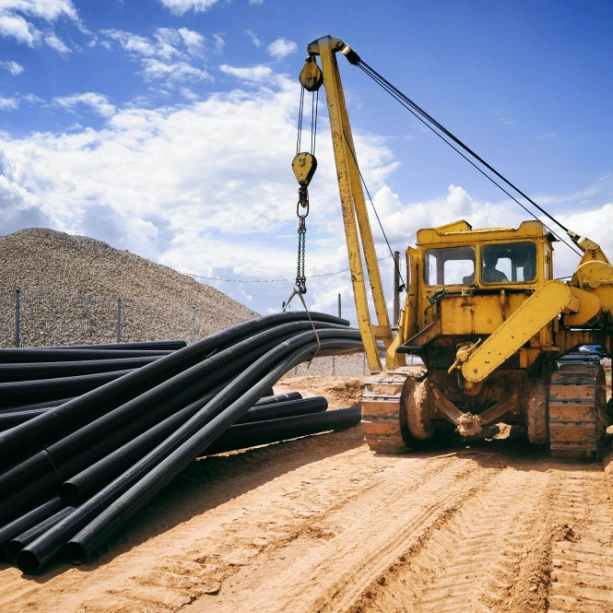In today's fast-paced and highly competitive business environment, the ability to effectively track and manage equipment has become increasingly important. Equipment tracking is the process of monitoring and managing the location, status, and utilization of key equipment. The ability to track equipment is especially essential for manufacturing operations, as the success of these operations are dependent on the ability to maintain high productivity, low costs, and worker safety. While all of these goals can be accomplished without equipment tracking, these methods make them a lot more attainable and enable operators to spend a lot less time worrying about these potential issues.
With advancements in technology, equipment tracking is quickly becoming more efficient and accurate than ever before. By using various technologies such as GPS, RFID, sensors, and more, companies are finding ways to render their manufacturing operations even more effective than they could have been with traditional equipment tracking alone. Let’s explore how technology is changing equipment tracking, the benefits it offers to businesses, and where that technology is headed in the not-so-far-off future.
How to Track Equipment with Traditional Methods
In order to better understand where we are today and the impact technology has had, we must first understand where we started. Before the advent of technology, equipment tracking was done manually, which involved keeping records on forms, spreadsheets, or simple internal databases. Even when these strategies utilized simple computers to store the information, input remained a manual task conducted by workers as they used or moved relevant equipment. They would record when they used or moved the equipment, and the next time someone else needed to use or move it, they would check the system to learn where it was and then record any changes after they completed their own task.
While this method is still used by some companies, it has several limitations. For example, it is time-consuming, prone to errors, and requires significant manpower. Although, perhaps the biggest flaw with this methodology: what happens when someone does not record equipment usage or location accurately or if they forget to record it at all? Manual equipment tracking cannot provide real-time visibility, making it difficult to track equipment accurately and rendering the system far less forgiving of human error. If you leave equipment in one place, forget to record the location, and forget where you put it, you’ll then have to go look for it yourself or even disturb your coworkers to conduct a search. Unwitting mistakes have a far more lasting impact when you apply traditional equipment tracking methods.
Increase Your ROI by Investing in AirFinder OnSite
- Low Cost. AirFinder OnSite XLE is a fraction of the cost of competitors' pricing.
- Long Battery Life. XLE lasts up to 7 years with hundreds of location updates daily.
- Increased Efficiency. Spend less time looking for assets, and more time being productive.
How to Track Equipment with Technology
Advancements in technology have strived to make equipment tracking more efficient and accurate while eliminating the shortcomings of manual tracking. The most commonly used technology-enabled tracking methods include GPS tracking, RFID tracking, and IoT-enabled tracking. GPS tracking uses satellite signals, RFID tracking uses radio waves, and IoT-enabled tracking involves the use of sensors and wireless networks. Each of these technologies can either be used on their own or in some combination with one another. There are, of course, other technologies and combinations beyond these examples – these are simply the most well-known. That being said, it’s worth noting that many of the most effective and most advanced equipment trackers for manufacturing involve some element of IoT and applications of sensors. This technology is, after all, far more precise and has greater use within set locations. It can help identify where in a building or on a campus the desired equipment is located, while GPS is more useful when tracking between remote locations.
The development of these equipment tracking systems in their modern iterations would not be possible without the development of some core technologies and technological concepts. Some of the developments that have contributed over the years include:
- IoT and Cloud Computing. The use of IoT sensors and cloud-based platforms enable businesses to monitor the location and usage of their equipment in real time.
- AI and Machine Learning. Algorithms enable advanced data analytics for the prediction of patterns, equipment failures, and performance optimization that can be applied to improve operations and equipment handling.
- Edge Computing. By processing data closer to the source, edge computing can reduce latency and improve data security, making these equipment tracking systems more affordable and more effective.
Benefits of Using an Equipment Tracker
There are any number of benefits to tracking equipment within manufacturing operations. The prevalence of any given benefit will, of course, rely on your company’s specific needs and operations, as well as the size and scope of the system that you choose to use. Some of the best benefits afforded to businesses with equipment tracking systems include:
Improved Equipment Utilization
By letting you know what equipment is or isn’t being used at any given time, real-time tracking of equipment helps your business efficiently allocate resources, reducing idle time and maximizing the utilization of equipment. This leads to increased productivity, as well as a longer lifespan for equipment. Essentially, workers will be able to know when the equipment they need is available so that they can complete their tasks right away, and operators can better enforce rotations of equipment usage to ensure that it lasts longer.
Reduced Maintenance and Replacement Costs
Equipment tracking also enables the early detection of equipment issues, which leads to repairs and replacements. When operators know that equipment is showing signs of damage, they can remove it from use and repair it before it is rendered unusable from neglect. Quicker, more timely repairs typically mean easier repairs; repairs in general mean less replacements. This strategy reduces unexpected downtime and saves businesses money on costly replacements. Predictive maintenance is also an important aspect of equipment tracking, as it helps prevent equipment breakdowns before they happen, which provides further benefits to equipment uptime and reduced costs.
Enhanced Productivity and Customer Satisfaction
As one would expect, productivity is a key benefit of equipment tracking. However, as one might not immediately assume, improved customer satisfaction is a direct consequence of that. By optimizing equipment utilization and minimizing downtime, employees are able to work with less interruption and more certainty, giving them the ability to maintain efficiency across operational hours. When your manufacturing operations obtain this level of consistency, you can better ensure the accurate and timely shipment of your products. Even when something does go wrong, equipment tracking enables businesses to provide customers with up-to-date information on any changes in production and shipment projections, leading to a reputation of communication and transparency.
Ensured Worker Safety
Equipment tracking can also help reduce workplace accidents and injuries by ensuring equipment is maintained and operated safely. Poorly maintained equipment is more likely to fail; equipment on the verge of failure is more likely to cause safety issues. Even beyond this, equipment tracking makes record-keeping far more accurate and consistent, which makes it easier to identify when equipment falls out of compliance with safety regulations and needs to be dealt with. By using equipment tracking to keep a more constant eye on these regulations, employees are able to work in a safer environment, leading to improved morale, job satisfaction, and worker retention.
Advanced Environmental Benefits
Safety regulations aren’t the only matters of compliance that equipment tracking can help with – they can also help achieve compliance with environmental regulations. Different manufacturing operations have to pay attention to different environmental regulations, but the core benefit from equipment tracking has to do with the monitoring of resource usage. This is most directly related to fuel consumption and emissions, which can be calculated with the usage data that comes from equipment trackers. It can also help monitor what resources are being used in production as components to ensure they are being used in the most effective way possible and keeping production waste to a minimum.
What is the Future of Equipment Tracking?
The technology of IT equipment tracking has come a long way since companies were limited to just paper trails or even digitized manual-input databases. The current technology provides far more benefits and helps solve problems that older methods of tracking could not. That does not mean that equipment tracking has been perfected. As surely as new technology will be invented, equipment tracking systems will continue to evolve with the resources available to the people who make them. We can’t know the future, so we can’t know exactly what that will look like, but we can make speculations about what further developments in equipment tracking technology will prioritize based on the priorities of current technologies and recurring problems with equipment.
Increased Automation
Equipment tracking technology in its current iteration is already greatly concerned with automation. A tracking system that does not require manual input is, after all, a tracking system that is safeguarded from human error. We have already achieved significant automation within equipment tracking, but subsequent systems could be made more responsive to their environment, allowing them to shift between settings based on internal data analysis in order to facilitate smoother operation. This type of automation continues to be a priority across businesses, as it saves operators from having to manually change settings that they would prefer to be responsive.
Improved Supply Chain Management
The supply chain is always a concern for companies with manufacturing operations. Whether it’s monitoring the supply chain for product components or monitoring the company’s own product output, visualizing the flow of materials is at the core of a company’s ability to analyze and improve their operations. Equipment trackers that are also equipped to track the movement of products throughout the manufacturing process without any additional components or accrued costs are a viable possibility for the future of this technology.
Greater Access to Real-Time Data
Real-time data is already a priority for equipment tracking technology, as it is already a priority for the companies that use that technology. After all, real-time data means full visibility and the ability to make decisions based on current data rather than outdated – and potentially irrelevant – historical data. Future equipment tracking systems will likely continue to prioritize real-time data and seek to apply it across a wider range of uses and data points than what is currently able to be supported. Fortunately, this sort of benefit is likely not far off at all, as IoT’s ability to provide real-time data is becoming more and more refined each and every year.
New Business Opportunities
Overall, the priority of these potential branches for future equipment tracking comes down to a single, shared priority – the realization and pursuit of new business opportunities. The capabilities of equipment tracking systems will naturally be influenced by the ever-evolving needs and priorities of the industries they serve. However this technology changes and however quickly it changes, it will change in a way that reflects the manufacturing industry’s pursuit of new business opportunities and what operators need to achieve their own changing goals.
AirFinder Onsite for Equipment Tracking
Are you looking for a reliable, adaptable equipment tracking system to help improve your business’s manufacturing operations? Link Labs might have the answer! Our AirFinder Onsite solution helps you monitor your equipment in indoor and campus-based environments. Perfectly designed for manufacturing plants, AirFinder Onsite enables you to monitor the location and usage of your equipment with complete asset visibility so that you can make better decisions and reach your full potential. To learn more about how this solution can work for your equipment tracking needs, book a demo today!





